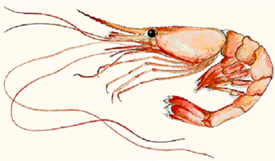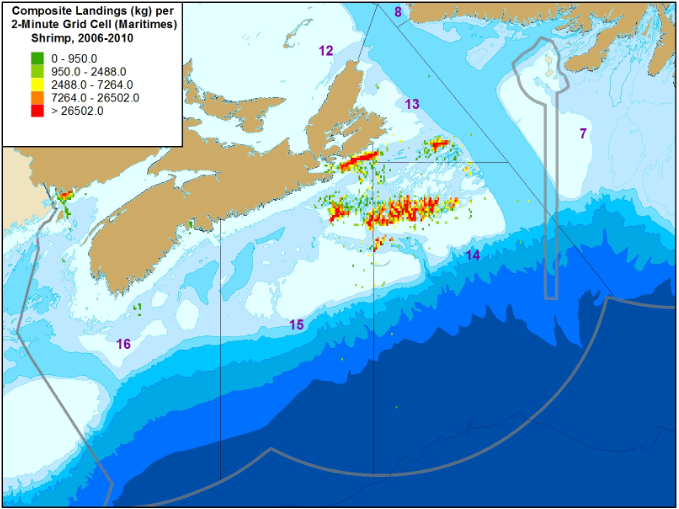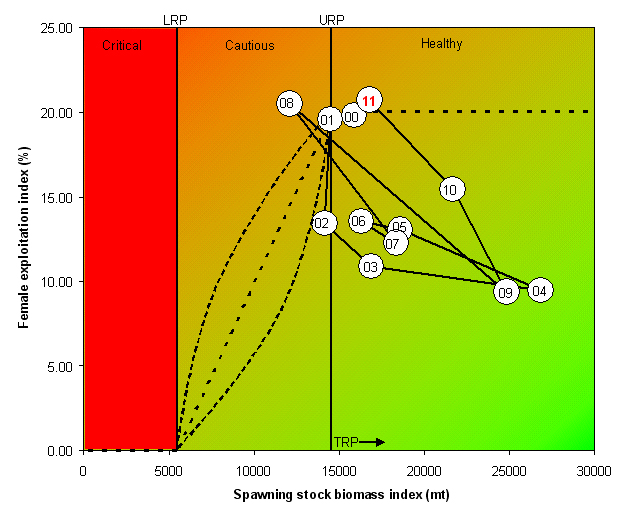Shrimp (Pandalus borealis) - Scotian Shelf - As of 2013

The purpose of this Integrated Fisheries Management Plan (IFMP) summary is to provide a brief overview of the information found in the full IFMP. This document also serves to communicate the basic information on the fishery and its management to Fisheries and Oceans Canada (DFO) staff, legislated co-management boards and other stakeholders. This IFMP provides a common understanding of the basic “rules” for the sustainable management of the fisheries resource. The full IFMP is available on request.
This IFMP summary is not a legally binding instrument that can form the basis of a legal challenge. The IFMP can be modified at any time and does not fetter the Minister's discretionary powers set out in the Fisheries Act. The Minister can, for reasons of conservation or for any other valid reasons, modify any provision of the IFMP in accordance with the powers granted pursuant to the Fisheries Act.
Where DFO is responsible for implementing obligations under land claims agreements, the IFMP will be implemented in a manner consistent with these obligations. In the event that an IFMP is inconsistent with obligations under land claims agreements, the provisions of the land claims agreements will prevail to the extent of the inconsistency.
Signed: Regional Director, Fisheries Management, Maritimes Region
General Overview
Shrimp fishing has occurred on the Scotian Shelf since the 1960s. However, groundfish bycatch in the small mesh shrimp trawls prevented the shrimp fishery from reaching its full potential until 1991, when the Nordmore separator grate was introduced. At that same time, the shrimp population on the Eastern Scotian Shelf began to increase as a result of favourable environmental conditions and ecological factors.
Initially, shrimp fishing on the Scotian Shelf was concentrated in Shrimp Fishing Area (SFA) 16, which is off Southwest Nova Scotia. The fishery there peaked in 1970 with 50 vessels landing 800 tonnes. By 1977 the SFA 16 stock had decreased substantially. Aside from a surge in 2010, recent landings have been very low to nil. Currently, there are 18 otter trawl licences in SFA 16 that fish the stock on an opportunistic basis. There is also one shrimp transport licence.
In more recent years the main shrimp fishery on the Scotian Shelf has been an otter trawl fishery in SFA 13-15, and this fishery is the focus of the IFMP. Mid- and near-shore vessels from New Brunswick and Nova Scotia fish the deep “shrimp holes” on the Eastern Scotian Shelf – Louisbourg Hole, Canso Hole and Misaine Hole – and an area closer to shore known as the Bad Neighbour Shoals. The fishery is open year-round, but most of the fishing is done from late winter to early summer.
Figure 1. Landings of Scotian Shelf Shrimp (SFAs 13-16)

There is also a small trap fishery in Chedabucto Bay (SFA 15), the body of water separating Cape Breton from mainland Nova Scotia. The trap fishery developed in the mid-1990s and serves a niche market for trap-caught shrimp. There are 14 trap licences in total with an allocation of 100 traps each. Five of the licences are located in the north of Chedabucto Bay, eight in the south, and one along the eastern shore just south of the bay. The trap fleet is active primarily from late fall through winter.
The shrimp in SFA 13-15 are managed as one stock, and a Total Allowable Catch (TAC) is set each year. The long-term yield from SFA 13-15 is considered to be in the range of 3000 to 5000 tonnes annually.
The shrimp in SFA 16 are likely part of the Gulf of Maine stock. There is no TAC in SFA 16.
Stock Assessment, Science & Traditional Knowledge
The northern or pink shrimp, Pandalus borealis, is the only shrimp species of commercial importance on the Scotian Shelf. The shrimp appear to prefer temperatures of 2 to 6o Celsius and a soft, muddy bottom with a high organic content. In the Gulf of Maine, sea surface temperatures have been correlated with changes in the shrimp populations, with higher surface water temperatures leading to decreased shrimp abundance. It is possible that the lower water temperatures on the Eastern Scotian Shelf in recent years contributed to observed increases in the shrimp population in this area.
The SFA 13-15 stock is assessed annually. Assessments are based on data from an annual, co-operative DFO/industry trawl survey, catch per unit effort indices derived from commercial fishing log data, and commercial catch samples collected throughout the fishery. Further indices of shrimp abundance, shrimp production, fishing effects and ecosystem health are used to provide a broad overview of factors thought to be associated with the status of the SFA 13-15 stock.
The SFA 13-15 stock is considered to be in a period of sustained high productivity, characterized by high and stable catch rates and survey biomasses fluctuating at relatively high levels in response to variable recruitment. Despite recruitment fluctuations driven by biological and environmental factors, high productivity is sustained by continuing low natural mortality, potentially due to the non-recovery of groundfish stocks.
Stock status reference points consistent with DFO’s A fishery decision-making framework incorporating the Precautionary Approach have been set for SFA 13-15. The size of the stock in relation to these reference points, along with the values and trends of the other indicators, guides the selection of the annual TAC. See Table 1 and Figure 2.
Figure 2: Graphical representation of the precautionary approach to harvesting shrimp in SFA 13-15

The Upper Sock Reference (USR) corresponds to 80% of the average spawning stock (female) biomass during the modern fishery, i.e. the period of 2000 to 2010, and the limit reference point (LRP) to 30%. The LRP is also approximately equal to the average spawning stock biomass during a period of low shrimp productivity, i.e. the period before 1990. This period of low productivity is characterized by low shrimp abundance, high groundfish abundance and relatively warm temperatures. The LRP is thus set to avoid a decrease in shrimp abundance below the level at which it was previously able to fulfill its role as a food source for healthy groundfish stocks.
There is no stock assessment or decision-making framework for SFA 16.
Economic, Social, Cultural Importance
With respect to the overall commercial fishery in the Maritimes Region, the Scotian Shelf shrimp fishery is small, representing less than one percent of landed value. However, the fishery provides important economic benefits to harvesters along the eastern shore of mainland Nova Scotia, south-eastern Cape Breton, and in the southern Gulf of St. Lawrence. It also generates significant benefits to the coastal communities where the shrimp is landed and processed.
Landings from the fishery have fluctuated over the last two decades, reaching a peak of 5,454 t in 2000 before decreasing to just under 2,800 t in 2003, and rising again to approximately 5,000 t in 2010. Landed value peaked at $12.0 million in 2000. This was followed by a steady decline to an estimated landed value in 2010 of approximately $4.8 million.
For the 2001 to 2010 period, the average landed price reported for shrimp in the Scotian Shelf fishery reached a high of $2.26 per kilogram in 2002. Following that high, price declined significantly; the average price from 2006 to 2010 was approximately $1.03 per kilogram. Pressures that are likely to have contributed to this decline include an increase in the global supply of shrimp and a strong Canadian dollar.
Access and Allocations
The Minister can, for reasons of conservation or for any other valid reasons, modify access, allocations and sharing arrangements outlined in the IFMP in accordance with the powers granted pursuant to the Fisheries Act.
In SFA 13-15, the mobile fleet holds 92% of the TAC. Of this, 25% is held by Gulf-based vessels and 75% by Maritimes-based vessels. The mobile fleet has been operating under a system of individual transferrable quotas since 1998. The trap fleet holds 8% of the TAC. Trappers fish their share competitively.
In SFA16, the stock is fished competitively.
Governance Process
The shrimp survey in SFA 13-15 is carried out every year in June. Data from the survey, along with data from the analysis of commercial samples, are analyzed through the summer and fall by DFO Science. In late fall, DFO Science provides advice to DFO Resource Management on harvest levels for the next season in the form of a stock assessment. This advice is considered by the Eastern Scotian Shelf Shrimp Advisory Committee (ESSSAC) at its annual meeting, which is held in January or February, and the ESSSAC recommends a TAC. The final TAC is determined by the Regional Director General, Maritimes Region in late winter, and allocations and licence conditions are updated for the 1st of April. A provisional TAC is sometimes approved if fishing starts in advance of the approval of the final TAC.
Shared Stewardship Arrangements
The fishery in SFA 13-15 is managed cooperatively with the shrimp fishing industry, provincial authorities and Aboriginal groups. Representatives form part of the ESSSAC, which provides advice on the annual TAC, among other things. Licence holders in SFA 13-15 also contribute financially to the science program, and a joint project agreement guides the conduct of the annual shrimp survey.
Given the low level of activity in SFA 16, there is currently no industry advisory committee for the area. Licence holders are consulted on an ad hoc basis, as required.
Management of the Fishery
Through IFMPs, DFO Maritimes Region is implementing an Ecosystem Approach to Management (EAM) across all marine fisheries. EAM is a management planning framework. Management planning requires the specification of objectives (what you want to achieve), of strategies (what you will do to manage human induced pressures so that you can achieve your objectives), and tactics (how you will implement your strategies). The objectives, strategies and tactics for the shrimp fisheries in SFA 13-15 and SFA 16 are presented in Table 3, which is attached to this summary.
Compliance Plan
The trawl fleets in both SFA 13-15 and SFA 16 are subject to 100% dockside monitoring and up to 5% at-sea observer coverage. The trawl fleet in SFA 13-15 is also required to have an electronic vessel monitoring system in place. The trap fleet is subject to 20% dockside monitoring.
Reports on fishing activity in closed areas are generated as often as daily as part of on-going compliance monitoring of protected areas in the Maritimes Region.
DFO also carries out air, sea and land patrols and engages in educational activities as needed.
| 2006 | 2007 | 2008 | 2009 | 2010 | 2011 | |
|---|---|---|---|---|---|---|
| Total Hours | 199.75 | 197.5 | 112 | 80.75 | 91 | 135.75 |
| Enforcement Hours | 199.75 | 194.0 | 108.5 | 69.75 | 90 | 93.5 |
| Stewardship and Other Program Hours | 0 | 3.5 | 3.5 | 11.0 | 1 | 42.25 |
Performance Review & Plan Enhancement
The IFMP is reviewed broadly by DFO and the ESSSAC every year. Sub-committees of the ESSSAC are set up as needed to develop recommendations on matters requiring in-depth discussion.
Landings are monitored continually, and quota overruns are deducted on a 1:1 basis from the licence holder’s allocation for the next year.
Starting in 2012, a full peer review of the stock assessment for SFA 13-15 will be held every two years (rather than every year). The review will include consideration of the need to refine or change the precautionary reference points and harvest strategies.
Bycatch from at-sea observer data will be reported in the shrimp stock assessment and will be reviewed every two years.
Over the coming years, the principal enhancement planned for the IFMP concerns the impact of the fishery on sensitive benthic areas. DFO is continuing to collect and analyze data on the distribution of corals and sponges in Canadian waters, their ecological function, and the risks they face from bottom-contact fishing. The pressure from the shrimp fisheries on ecosystems supported by corals and sponges will be reviewed as DFO’s understanding of these and other types of sensitive benthic areas progresses.
In addition, should economically viable shrimp stocks be found in SFA 16, management measures for the SFA 16 fishery will need to be enhanced.
Fisheries and Oceans Canada Contact
For additional information on this IFMP Summary, or to request an electronic version of the full IFMP, please contact Resource Management, Maritimes Region (902-426-5952).
Management of the Fishery
- Date modified: